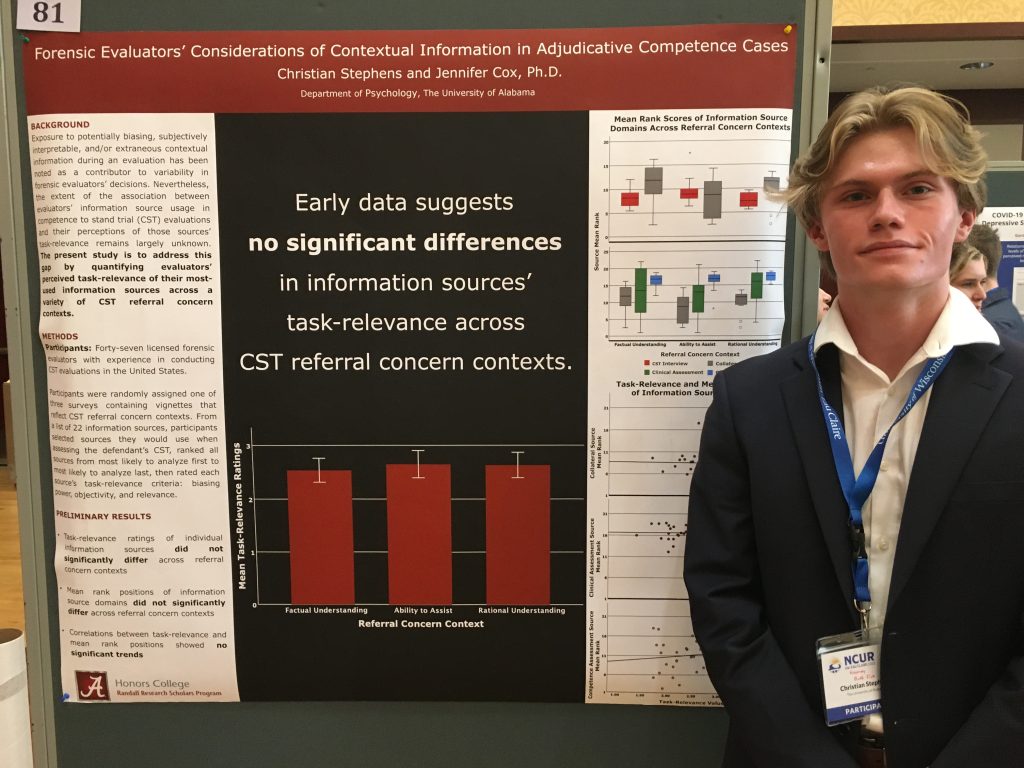“ASSURE program is more than a boon for undergraduate research – it is a ladder toward realizing possibility and achievement” – these are the words of Christian Stephens, an ambitious undergraduate researcher who unravels the complexities of competency to stand trial evaluations. His journey started from webpage foraging to presenting groundbreaking findings at prestigious conferences, all made possible by the support of dedicated mentors and the ASSURE program. This story is not just about research; it’s a testament to the transformative power of opportunity in the pursuit of knowledge.

Within the realm of undergraduate research, there are, unfortunately, few opportunities for aspiring researchers to obtain funding for their various projects. Broken down further to their respective colleges and disciplines, even fewer opportunities present themselves. In my search for funding, my options were relegated to seasonal, external awards supplied by organizations such as the Psi Chi Psychology Honor Society or internal support sponsored by The University of Alabama – it was for this reason that I applied for ASSURE grant funding and, likewise, why it was imperative for the completion of my project. Having learned of the ASSURE program through webpage foraging, I immediately began preparing my grant materials in October of 2022 in anticipation of its November deadline. After receiving funding in December of this past year, I proceeded with the execution, completion, and dissemination of my research and its results.
My research investigated contemporary issues in the field of forensic psychology as they applied to competency to stand trial (CST) evaluations. A CST evaluation is a pretrial examination that assesses a defendant’s factual and rational understanding of court proceedings as well as their ability to assist in their own trial. Referral concerns about a defendant’s competency, or the reason why they were referred for a CST evaluation, can range from incomprehension of the adversarial nature of the criminal legal process to an inability to communicate effectively due to the presence of psychotic symptoms. In all instances, the specific collateral and assessment information sources used by forensic psychologists and psychiatrists during an evaluation are critical components towards determining competency. To avoid biased outcomes, these information sources must provide relevant details that aid in decision-making and contain as little irrelevant contextual detail as possible. This balance comprises a source’s task-relevance, which is based upon criteria of biasing power, objectivity, and relevance. However, a source’s task-relevance may fluctuate depending on the referral concern. Therefore, the overarching goal of my study was to determine forensic evaluators’ perceived task-relevance of their most-used information sources across a variety of CST evaluation referral concerns.
In consideration of its execution, I aimed to collect responses regarding the aforementioned variables via an online survey distributed to licensed forensic evaluators in the United States. Recruitment approaches included email solicitation using professional psychology-law listservs (American Psychology-Law Society [AP-LS] and PSY-LAW) and directly contacting forensic clinicians with postdoctoral clinical internship websites listed on the Association of Psychology Postdoctoral and Internship Centers directory. Recruits were then randomly assigned to one of three surveys reflecting clinically plausible referral concerns, each of which addressed either a hypothetical defendant’s factual understanding, rational understanding, or ability to assist their counsel. Following data collection, I then ran various analyses to determine potential significant differences of information source usage, prioritization, and perceived task-relevance across concern contexts. Thankfully, all went according to plan with little variation or consolidation within my original study design being necessary.
I have used the awarded funds to purchase Laerd Statistical Tutorial Software, to gain access to the AP-LS listserv, to purchase an AP-LS student membership, and to recruit participants. The remaining funds were used to partially fund my trip to the National Conference on Undergraduate Research, which was held in Eau Claire, Wisconsin.
With respect to my project outcomes, I presented the findings of my research at two scientific conferences and will present it at another in the near future. I first presented my research via poster at the Undergraduate Research and Creative Activity Conference at The University of Alabama. I then flew to the University of Wisconsin, Eau Claire for the National Conference on Undergraduate Research in mid-April, 2023 where I also presented my research poster. This March, I attended the Annual Conference of the American Psychology-Law Society in Los Angeles and presented my research in an oral format. In addition to these conference experiences, I reported my research progress and findings during the last two Randall Research Scholars Live presentations. I also submitted my complete manuscript to Law and Human Behavior, a noteworthy journal within the field of forensic psychology, which is currently under review.
My mentor, Dr. Jennifer Cox, was nothing short of wonderful to work alongside over the duration of my project. She allowed me to take full control of my research conception, design, and implementation while affording advice and scholarly insight as needed. Cadi Fung, the previous ASSURE program director, was also extremely accessible and motivated towards helping me carry out my project throughout all stages of development. Without their insight and the funds provided by the ASSURE grant, my project would not have unfolded as fluidly as it did. Thus, I would highly recommend other eager students apply for the ASSURE program should they possess bright, novel ideas with distinct outlines for execution but need more means to realize them. This program is more than a boon for undergraduate research – it is a ladder toward realizing possibility and achievement.